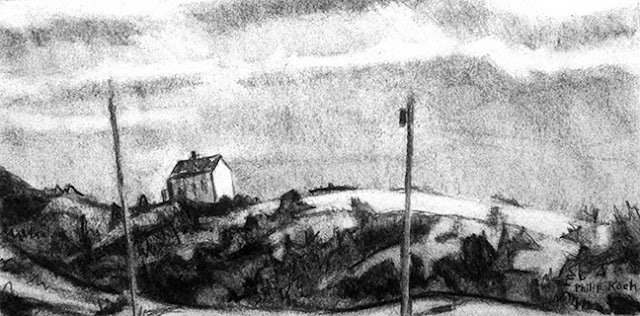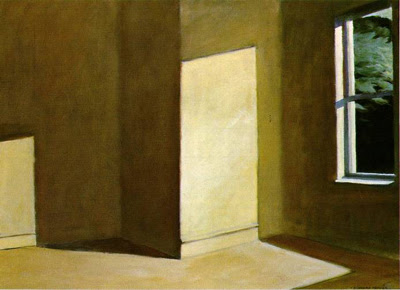Orchestrating an Exhibition or a Painting
If you are really small you might be able to tour the Delaware Art Museum's Centennial Juried Exhibition before it opens. You could crawl around this scale model of the show with all the works to be displayed reproduced in tiny versions on the walls of the Museum's gallery. The scale model of the show was arranged by Margaret Winslow, the Assistant Curator of Contemporary Art. Her crew had the model out to show them where to place the pieces as they arrived in the Museum earlier this week. I think it looks really cool. Here's my painting hanging on its trusty FoamCore wall below. (You can see a better image of it here),
After I delivered my painting to the Museum on Tuesday, I checked out painting studio where I've been invited to teach a landscape painting and drawing workshop on Oct. 21 with Saralyn Rosenfield. In addition to overseeing the Museum's studio classes, Saralyn helps by writing some of the educational material that accompany the Museum's shows. Over lunch Saralyn told me the Delaware Art Museum's Edward Hopper oil Sumertime was just accompanied across the Atlantic by one of the Museum's Curator of American Art, Heather Campbell Coyle, to join the big Hopper show in Paris at the Grand Palais from Oct. 10- Jan. 28, 2013. (here's a link to a post where I wrote about the DAM Hopper painting) Let's face it, sad as it is to see this star of DAM's collection leave Wilmington, we need to share it with the less fortunate in that cultural backwater of Paris.
I'm kidding, but the DAM's Hopper is a real show stopper and will be a fabulous addition to the huge Hopper retrospective there. The show actually started in Madrid over the summer. I blogged a couple of months ago about a wonderful video giving an overview of the Madrid version of the exhibition. In addition to showing the work in the Madrid museum, the video's producers sent a camera crew to the US and traveled up to Nyack, NY to visit Hopper's boyhood home. There's a great section where the Director of Edward Hopper House Art Center, Carole Perry, brings the crew upstairs to see Hopper's bedroom where a show of my own work was hanging. My paintings depicted Hopper's Truro studio on Cape Cod. (this is at minute 3:30 in the video). Here's the link to the video (in Spanish, but even us non-speaker Hopper lovers will enjoy it)
Hopper Video
Often I write about Hopper's art as it's been so valuable to me- teaching me so much about painting. Probably the key ingredient making Hopper remarkable is his brilliance at evoking the intensity and the specific moods of sunlight. Later this fall I'm headed up to Cape Cod for my 14th residency in Hopper's S. Truro studio. It's fun to compare the light in the city streets of DAM's Summertime above with Hopper's oil of his Truro driveway, The Camel's Hump, below (in the collection of the Munson Williams Proctor Arts Institute in Utica, NY). When I'm up there I'll be parking my car just at the right side of this painting.
Hopper positioned himself just off to the side of his sandy driveway and is looking south back toward the high dunes that form the ridge upon which his studio is perched. His garage and the long steps up to the studio are just off to the right, out of the picture. The driveway is the thin band of cooler beige color that goes all the way from the left to the right side of the painting at about one third of the way up from the bottom. The artist waited until late in the afternoon to get this particular pattern of sunlight and shadow. It neatly divides the space into a light-drenched foreground and a heavily shadowed background.
Notice how Hopper changes the quality of the highlights from foreground to background. Upfront he leans on the intensely bright yellows and yellow ochre greens, keeping them just as tonally light as he can. Compare that to the deliberately darker highlights he reserves for the background dunes. He wants the two spaces to feel different to the viewer, so he devises a different quality of light for each space.
Probably the foreground was the harder of the two spaces to paint as is lacks the high contrast shadows that model the clear volumes of the big dunes. But it's in just such passages that Hopper shows himself a master of color. There's a greener, less yellow little pathway of grasses that march from the driveway and down off the center bottom of the canvas. It provides a much needed note of cooler and less intense color to play off the sizzling yellows of all the other surrounding grasses. Hopper knew in his bones that to evoke a brilliant sense of light a painter has to paint with a range of intensities to his colors. He does that so well here, as well as giving us a range of color temperatures to the foreground.
We've all seen paintings that just don't hold together well. But we've seen the opposite too in Hopper's Summertime and Camel's Hump. I imagine Margaret Winslow spent many hours repositioning her images of works for her upcoming Centennial Juried Exhibition on different walls in her scale model. Making a show pull together is a whole lot like what Hopper did in the two oils pictured here. A curator has to try this and then try that, seeing how neighboring pieces resonate with each other or fight against what they're stuck next too. It's not a science, it's an art. Curators, like artists, must master patience.
Delaware Art Museum's Centennial Juried Exhibition opens with a ticketed reception Friday, Oct. 19 and runs through Jan. 13, 2013. The work was selected by John B. Ravenal, the Lewis Family Curator of Modern and Contemporary Art at the Virginia Museum of Fine Arts.






